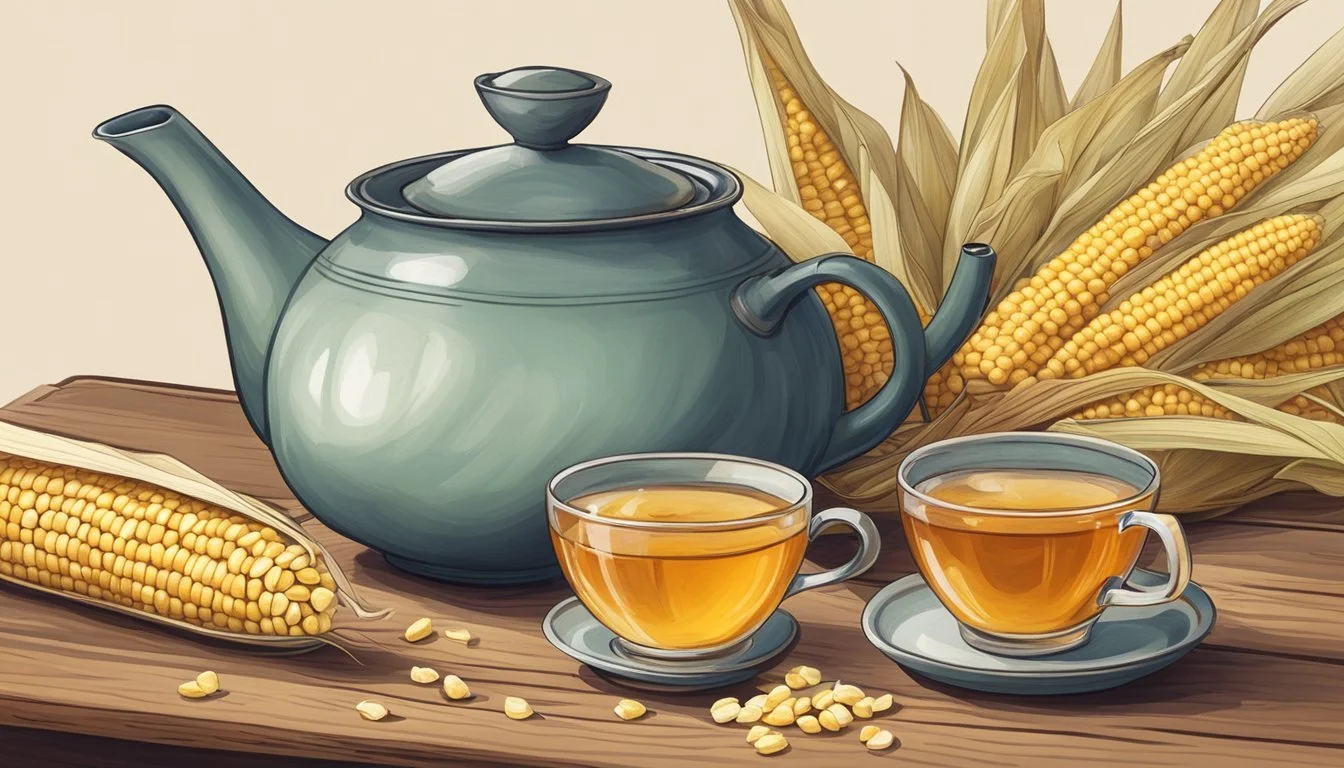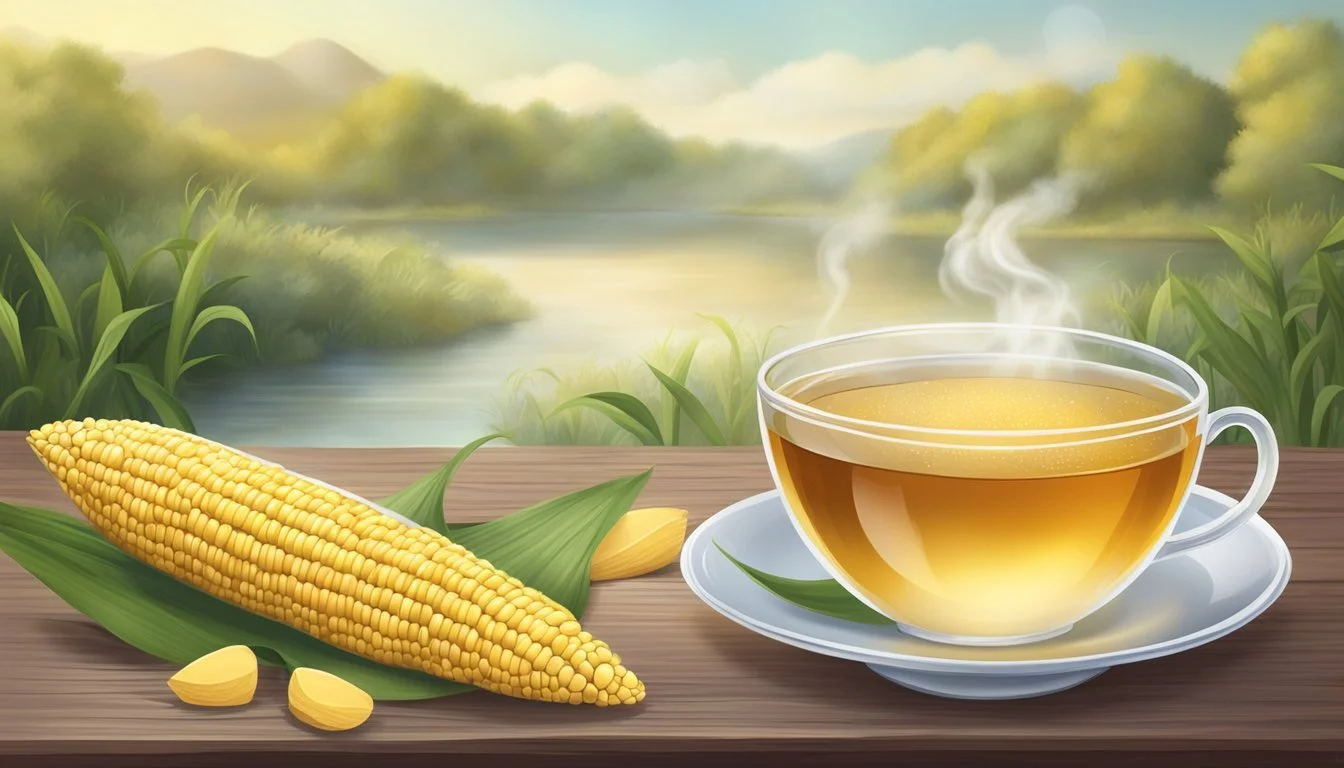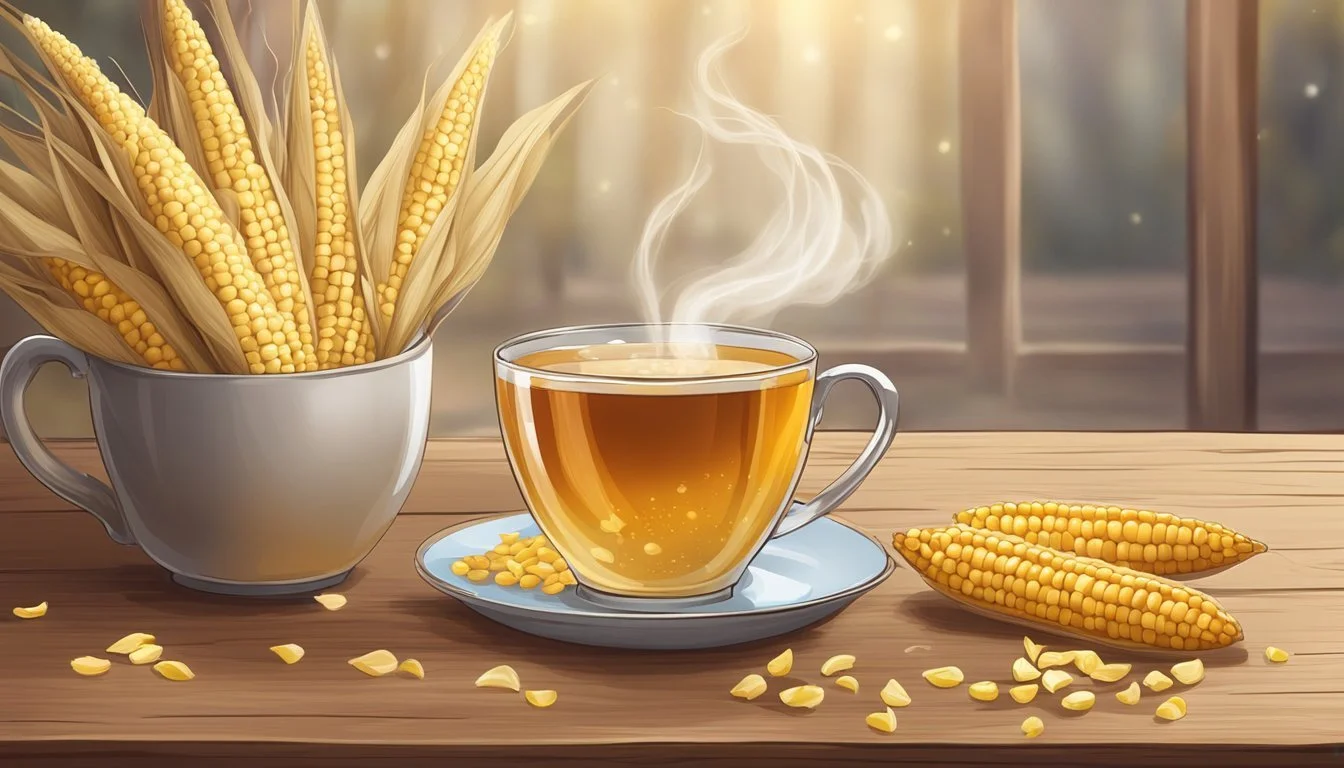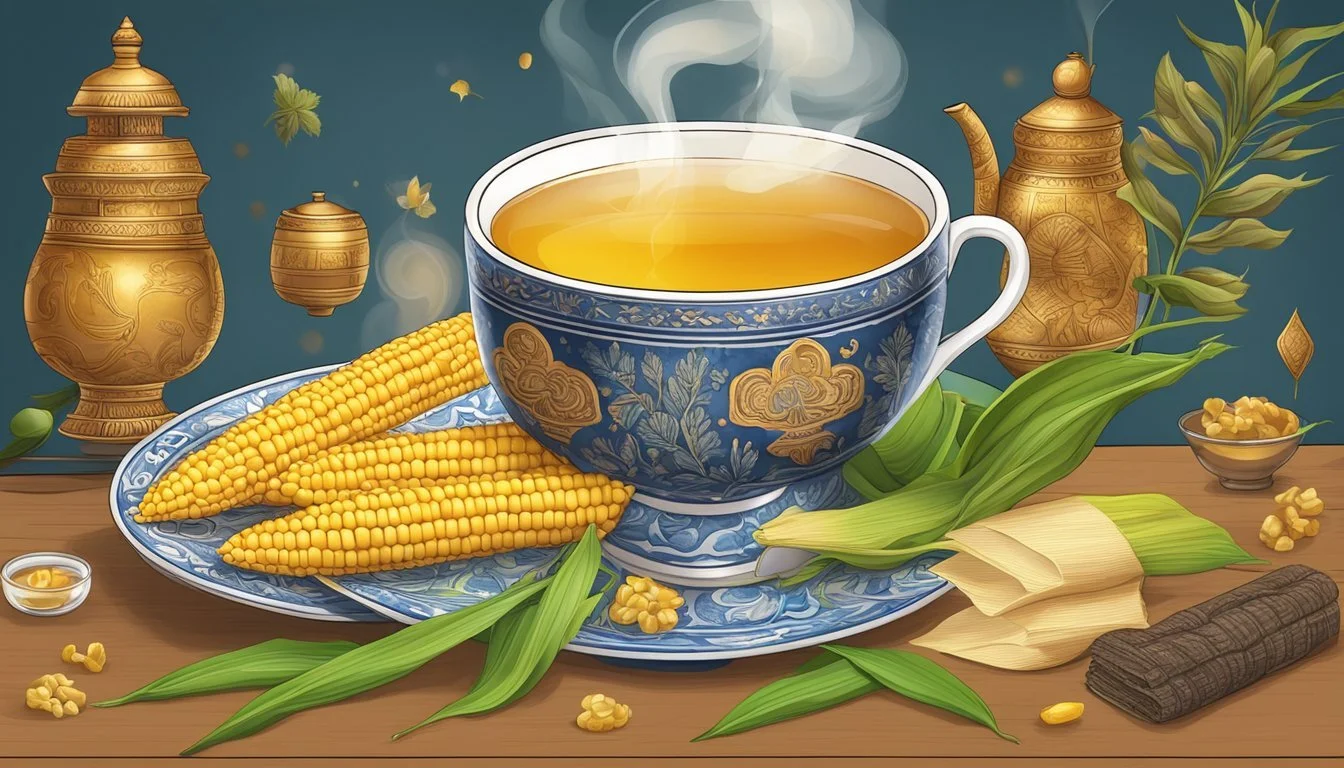Corn Silk Tea
Exploring Its Diuretic Benefits and Soothing Qualities
Corn silk tea, a beverage steeped in tradition, is made from the long silky threads found beneath the green husk of corn cobs. This herbal infusion has been recognized for its soothing effects and its use dates back to ancient cultures where it was treasured for its medicinal properties. Historically, corn silk has been harnessed by Native Americans and Chinese practitioners, who have long incorporated it into their healing practices, embracing its potential benefits for various health issues.
The tea derived from corn silk is believed to offer several health benefits. It is primarily known for its natural diuretic properties, which aid in flushing out toxins from the body. By facilitating the removal of excess fluids, corn silk tea can help with conditions related to water retention and may contribute to kidney health. Additionally, it is suggested that this herbal tea may have a role in managing blood pressure, elevating its status not just as a soothing beverage but also as a supportive drink for cardiovascular health.
Despite its heritage and potential benefits, corn silk tea is generally low in calories and does not contain measurable amounts of vitamins, minerals, or other nutrients. Its value lies in its diuretic quality and the anecdotal evidence of its therapeutic effects. The tea's subtle, earthy taste and its purported health advantages have made it a distinct addition to the herbal tea repertoire for those seeking natural remedies in their wellness journey.
What Is Corn Silk Tea?
Corn silk tea is an herbal tea made from the stigmas of the female corn plant, Zea mays. These silky strands, typically pale yellow or greenish in hue, are collected from the ears of corn and are revered in numerous cultures for their potential health benefits.
Origin & Traditional Uses:
Native American Heritage: Historically utilized by Native Americans for its medicinal properties.
Mexican Tradition: In Mexico, it's known as "té de elote" and is enjoyed for its soothing effects.
Preparation: Making corn silk tea involves steeping dried corn silk in boiling water. The taste is often described as mild and somewhat sweet, making it a pleasant beverage to enjoy on its own or with added sweeteners such as honey.
Usage in Traditional Medicine: Corn silk has been used in traditional medicine for its diuretic properties, helping to relieve fluid retention. Its applications extend to the potential alleviation of symptoms associated with conditions like inflammation, gout, and arthritis. Furthermore, it's sometimes used to support kidney health and urinary tract infections. However, the scientific research supporting these uses is limited and more studies are needed to verify its efficacy.
Nutritional Content: The beverage is virtually calorie-free and does not contain measurable amounts of vitamins or minerals, aligning with its use as a potential diuretic rather than a nutritional supplement.
In conclusion, corn silk tea is a herbal infusion with roots in traditional medicine, particularly among Native American populations and in Mexican culture. It is made using the delicate corn silk from Zea mays and is consumed for various perceived health benefits.
Historical Uses of Corn Silk
Corn silk, known for its diuretic properties, has been utilized throughout history for various medicinal purposes. Traditional Chinese Medicine (TCM) and Native American medicine are two systems that recognized its therapeutic potential early on.
In Native American medicine, corn silk was consumed as a remedy for several ailments but particularly for urinary tract conditions. Given its diuretic nature, it was employed to ease the symptoms associated with urinary tract infections and to promote general urinary tract health.
Similarly, in Traditional Chinese Medicine, practitioners valued corn silk for its ability to assist in flushing out the body's excess fluids, thereby improving kidney function and reducing the risk of urinary complications. The practitioners keenly observed and documented the herb's potential in mitigating water retention and promoting the smooth flow of urine.
The use of corn silk as a diuretic can be traced back to both these systems of traditional medicine. Diuretics help the body eliminate excess water by increasing urine production, which aligns with corn silk’s historical use in aiding the body to manage water retention and supporting the kidneys' ability to dispose of waste.
While formal medical studies in the past may not have been as prevalent as modern research, ancient healers' observations laid the groundwork for subsequent recognition of corn silk's beneficial properties. They carefully administered it to provide comfort for those suffering from urinary complaints and to support overall urinary tract health.
Health Benefits of Corn Silk Tea
Corn silk tea, a beverage derived from the silky tassels of corn husks, is traditionally recognized for its various health benefits. These benefits range from improving urinary tract health to aiding blood sugar regulation. Research supports some of these potential health advantages, though more robust scientific evidence is needed to confirm all of the claimed effects.
Diuretic Effects and Urinary Health
Corn silk tea acts as a natural diuretic, promoting increased urine production. This is beneficial for maintaining urinary health and can help in preventing the occurrence of kidney stones. Its diuretic properties may also assist in flushing toxins from the urinary system.
Blood Sugar Regulation
Studies have indicated that the consumption of corn silk tea might have a favorable effect on regulating blood sugar levels. This can prove significant for managing diabetes, as it assists in the maintenance of stable glucose levels in the bloodstream.
Anti-Inflammatory Properties
The anti-inflammatory qualities of corn silk tea are noteworthy. It contains natural compounds that may reduce inflammation, potentially helping with conditions such as arthritis. The antioxidants present in the corn silk may aid in countering oxidative stress, which is a contributor to inflammatory processes.
Cardiovascular Support
Corn silk tea is believed to provide cardiovascular benefits, particularly in terms of blood pressure management. It may help in lowering high blood pressure, thereby reducing the risk of heart disease. A regular intake of corn silk tea could support overall heart function, although more empirical studies are needed for conclusive evidence.
Digestive Aid
The soothing properties of corn silk tea can benefit the digestive system. It's thought to assist in alleviating digestive irritation and may help in regulating bowel movements. The presence of antioxidants in corn silk tea contributes to gut health, although specific nutrients like vitamin C are not measurable in the tea.
Skin and Beauty Benefits
Corn silk tea might also have applications in skin health, aiding in the reduction of hyperpigmentation and contributing to a clearer complexion. The anti-inflammatory effects can soothe various skin conditions, lending the tea a potential role in beauty regimens.
How to Make Corn Silk Tea
Preparing corn silk tea involves a simple method, whether utilizing fresh corn silk or dried. The process is quick and yields a drink known for its soothing and diuretic properties.
Using Fresh Corn Silk
To brew corn silk tea from fresh silks, one should gather the silky strands from one ear of corn. The process is as follows:
Rinse fresh corn silk under cold water to remove any debris.
Place the silk in a pot and add approximately 2 cups of water.
Bring the water to a boil, then reduce the heat to let the silk simmer for about 10 minutes.
After simmering, remove the pot from the heat and let the tea steep for an additional 20-30 minutes.
Strain the corn silk and serve the tea either hot or chilled.
Using Dried Corn Silk
For those opting to use dried corn silk, the protocol is slightly different:
Measure approximately 2 tablespoons of dried corn silk.
Place the dried silk in a pot with 2 cups of water.
Boil the water, then turn down the heat to a low setting and let it simmer for about 10 minutes.
Turn off the heat and let the silk steep for another 30 minutes.
Strain out the dried silk and enjoy the tea either warmed or over ice.
Sweetening and Flavoring Options
Corn silk tea carries a subtle, slightly sweet taste, but additional sweeteners and flavors can enhance the beverage:
Honey: A spoonful of honey can be added for a natural sweetening option.
Lemon: A splash of lemon juice can provide a refreshing tang and vitamin C boost.
Fresh herbs: Mint or lemon balm can be included in the steeping process for added flavor.
The tea can be personalized according to individual taste preferences, keeping in mind that the natural properties of corn silk are best enjoyed with minimal additives.
Potential Side Effects and Precautions
While corn silk tea is generally considered safe for many, there are some potential side effects and important precautions to consider.
Side Effects:
Allergies: Individuals with known allergies to corn or related plants may experience allergic reactions.
Diuretic Effect: Corn silk tea acts as a diuretic, increasing the frequency of urination which could lead to electrolyte imbalance if consumed in excess.
Interaction with Medication:
Diuretics and Blood Pressure Medication: Since corn silk tea has diuretic properties, it could potentially enhance the effects of prescription diuretics or blood pressure medications.
Blood Sugar Management: For those on diabetes medication, corn silk tea may affect blood sugar levels, necessitating a professional's advice to prevent hypoglycemia.
Precautions:
Kidney Stones: Individuals with a history of kidney stones should consult a healthcare professional before consumption, as the increased urination may affect kidney function.
Prostate and Breastfeeding: Men with prostate disorders and women who are breastfeeding should exercise caution and seek medical counsel prior to consuming corn silk tea.
In summary, while corn silk tea can offer various health benefits, it is crucial to consume it responsibly, particularly if one is affected by the above conditions or is under medication. Professional advice is recommended to prevent any adverse interactions or side effects.
Nutritional Profile of Corn Silk Tea
Corn silk tea is a traditional remedy with a subtle, slightly sweet taste. Despite its purported health benefits, the tea itself has a minimal nutritional profile. It is not a significant source of calories, protein, fat, or carbohydrates.
Nutrients: The primary constituent of corn silk tea is water, and as such, it contains negligible amounts of micronutrients. There is no measurable content of vitamins or minerals such as vitamin K, calcium, or potassium in a standard serving of the tea.
Fiber: It lacks dietary fiber since it is a steeped beverage, with the solid part of the corn silk typically discarded after brewing.
Antioxidants: While some herbal teas are noted for their antioxidant properties, there isn't robust scientific evidence to classify corn silk tea as a rich source of antioxidants.
Minerals: As with other nutrients, corn silk tea is not a reliable source of minerals. Any trace amounts that might be present are negligible and do not contribute substantially to the daily recommended intake.
Here is a simple breakdown of the typical composition of corn silk tea:
Nutrients Amount per 6 oz serving Calories 0 kcal Protein 0 g Fat 0 g Carbohydrates 0 g Fiber 0 g Vitamins None detected Minerals None detected Antioxidants Not quantified
It's important for consumers to recognize that the benefits of corn silk tea might come from traditional uses and anecdotal reports rather than its nutritional content. However, corn silk tea's potential diuretic properties contribute to its popularity in folk medicine for promoting kidney health and reducing fluid retention.
Integrating Corn Silk Tea Into Your Diet
Corn silk tea, known for its diuretic properties, is a caffeine-free beverage that can easily complement one's diet. It offers a hydration boost with virtually no calories, making it a suitable drink for those mindful of their liquid intake.
Individuals seeking to add this tea to their regular consumption can enjoy it hot or cold. Preparation is simple: one can steep fresh or dried corn silk in boiling water for a few minutes and then strain it. The tea has a gentle, sweet flavor, appropriate for various times of the day.
For a more structured approach, consider these suggestions:
Morning Routine: Replace your morning cup of coffee with a mug of warm corn silk tea to start the day hydrated without the effects of caffeine.
Meal Accompaniment: Drink a cup of corn silk tea with meals to aid digestion.
Evening Wind Down: Have a cup in the evening as part of a calming, nightly ritual.
Incorporating it into a lifestyle as a regular part of one's diet can support the body's natural healing processes due to its potential benefits for the urinary tract and kidney health.
Time of Day Suggested Use Morning Substitute for caffeinated beverages for a hydrating start to the day. Meal Times Drink alongside meals as a digestive aid. Evening Partake as a soothing beverage to unwind before bed.
One should consult with a healthcare provider before making significant changes to their diet or if they plan to use corn silk tea for specific health concerns. This ensures that the integration of this herbal tea into one's diet is done with consideration for individual health needs and in balance with a wholesome diet.
Harvesting and Storing Corn Silk
When harvesting corn silk, one should ideally select the silky strands from corn husks when they are bright green and moist, which typically denotes freshness. Farmers often gather corn silk just before the corn reaches maturation. It is vital to ensure that the strands are free from pesticides and other contaminants.
Dry: To dry corn silk, one can lay the strands out on a clean surface, ensuring they are well-spaced to permit optimal air circulation. A well-ventilated, shaded area away from direct sunlight aids in retaining the silk's color and properties. The drying process may take several days; one can tell the corn silk is properly dried when it becomes brittle to the touch.
Storage: After drying, the practice of properly storing corn silk is critical to maintain its quality. Storing it in an airtight container is essential to protect it from moisture and pests. A glass jar with a tight lid works well. The storage area should be cool, dark, and dry to prevent degradation of the corn silk.
Dos and Don'ts Table for Storing Corn Silk
Do Don't Store in a cool, dry place. Expose to direct sunlight. Use airtight containers. Leave container open to air or humidity. Check periodically for signs of moisture. Store near strong odors.
Following the above guidelines ensures that one has access to high-quality corn silk for tea-making or other purposes and preserves the green hue and gentle health properties associated with this unique plant product.
Corn Silk Tea in Various Cultures
Corn Silk Tea, derived from the long, silky threads that grow on corncobs, has been a cherished drink in various cultures for its medicinal properties. Rich in flavonoids, these silky stigmas carry potential health benefits, and different societies have leveraged this in traditional remedies.
In Chinese medicine, corn silk tea is known as "Yu Mi Xu" and has been used for its diuretic capabilities to promote urinary health. They often include it in formulations to support the kidneys and bladder, suggesting its ability to soothe urinary tract infections.
Latin American populations have a history of using corn silk, not only the stigmas but occasionally the leaves as well, in herbal teas to manage blood sugar levels and inflammation. They incorporate corn silk for its rumored benefits in conditions like hypertension and gout, reflecting a deep understanding of its potential anti-inflammatory properties.
Furthermore, cultures across North America have long recognized the diuretic nature of this plant element. Indigenous tribes have been utilizing corn silk tea to support various aspects of health, including the alleviation of kidney ailments.
Culture Common Uses Part Used Chinese Urinary health, Diuretic Stigmas Latin American Blood sugar, Inflammation Stigmas, Leaves North American Kidney health, Diuretic Stigmas
It's important to note that while there is anecdotal evidence and some scientific support for the medicinal use of corn silk, pollen is not typically associated with the tea, and research is ongoing to fully understand the efficacy of corn silk as a treatment option.
Environmental Impact and Sustainability
Corn Silk Tea is made from the silky threads found beneath the green husk of corn. The production of this tea intersects with sustainable agriculture practices given that corn silk is often a byproduct of corn farming. Utilizing corn silk for tea can minimize waste by repurposing a part of the plant that is usually discarded.
When farmers employ sustainable agriculture methods, such as crop rotation and reduced pesticide use, the environmental impact of corn farming, including the production of corn silk for tea, is mitigated. Sustainability in this context aims to preserve the ecosystem and reduce the carbon footprint associated with farming activities.
The earth-friendly aspect of corn silk tea production is contingent upon how the corn is grown. Ideally, organic farming practices should be used. When corn is grown organically:
Pesticides: They are largely avoided, reducing the contamination of soil and water.
Fertilizers: Natural methods are preferred, enhancing soil health and reducing harmful runoff.
Water Use: More efficient irrigation systems and practices can be implemented to conserve water resources.
By considering sustainability and agriculture practices in tandem, the environmental impact of corn silk tea production remains low. This approach contributes positively to the preservation of the earth's natural resources while providing a husk-derived health beverage for consumers.
Frequently Asked Questions About Corn Silk Tea
What is corn silk tea? Corn silk tea is a beverage made from the silky threads found under the husks of fresh corn, utilized traditionally for its potential diuretic and soothing properties.
Does corn silk tea contain caffeine? No, corn silk tea is caffeine-free, making it suitable for those who are sensitive to caffeine or wish to avoid it.
Can corn silk tea contribute to kidney stone prevention? Some believe corn silk tea may aid in the prevention of kidney stones by increasing urine flow, although scientific evidence to support this claim is limited.
Is corn silk tea beneficial for bladder infections? While anecdotal reports suggest corn silk tea can help soothe bladder infections by promoting increased urine flow, clinical data is insufficient to confirm this benefit.
Nutrition information:
Nutrients Quantity Calories 0 kcal Protein 0 g Fat 0 g Carbohydrates 0 g Magnesium Not measurable Amino Acids Not measurable
How can corn silk tea support weight management? Given its absence of calories, corn silk tea can be incorporated into a diet for those managing obesity, however, it should not be relied upon for weight loss.
Does corn silk tea have a role in reducing incontinence or supporting prostate health? While some proponents suggest that corn silk tea can improve issues like incontinence and potentially inhibit prostate cancer cells, there is no substantial scientific evidence to validate these uses.
Can corn silk tea affect bile production? There is limited information on corn silk tea's impact on bile production, hence one should consult a healthcare provider for advice on this matter.








